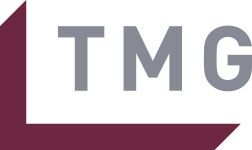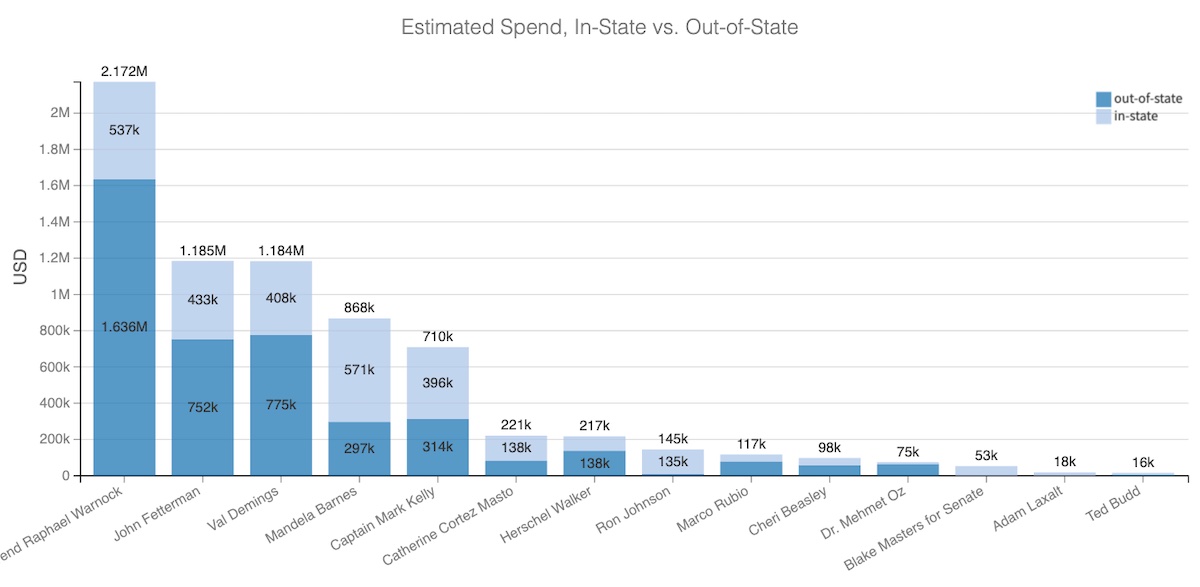By Grace Turke-Martinez, VP & Director of Analytics
October 19, 2022 – At The Messina Group, we are watching what leading campaigns are doing, both to stay in-the-know about the current political environment, and because campaign technology is constantly evolving.
The rise of misinformation and disinformation on social media, foreign interference in US elections, and the 2018 Facebook/Cambridge Analytica scandal drove Facebook to increase transparency around election-related advertising (at least superficially). One of these efforts is the Ad Library. This library includes ads about “social issues, elections or politics” on Meta platforms, which include Facebook and Instagram. The API allows researchers like us to query ads by keywords and return fields, including spend range, impressions range, the text fields for the ad, the states in which the ad was served, and the age-gender demographics to which the ad was served.
We decided to take a closer look at ads in competitive US Senate races to see who’s spending the most, what topics they’re discussing, and which demographics they’re targeting.
For this analysis, we looked at the Democratic and Republican candidates in Arizona, Florida, Georgia, Nevada, North Carolina, Pennsylvania, and Wisconsin. We chose these states because they are rated as “toss-up” or “lean” by the Cook Political Report, and they’re likely to be influential in the 2024 general election.
We queried Meta ads beginning 08/01/2022 through 10/19/2022 as of this writing, with candidates’ last names as keywords. It’s worth noting that in this analysis, we used the average of the spending range to estimate the amount spent per ad. In a direct comparison of stats based on the API search results and the web interface results, there may be some discrepancies because of how Facebook obscures spending and impressions to the public and because reporting can take up to 48 hours to be finalized.
Who’s spending the most?
Short answer: Raphael Warnock. Five of the top six spenders are Democratic candidates. By contrast, on the right, the top spenders are right-wing PAC Americans for Prosperity Action (#2 overall), and a right-wing non-profit, One Nation (#7 overall). A recent article from the New York Times documented Republicans’ reliance on PACs for TV advertising, compared to Democrats who do more advertising through candidate campaigns. We see similar trends in the Meta ads data: Democratic candidates do most of the spending, whereas Republicans lean more heavily on PACs.
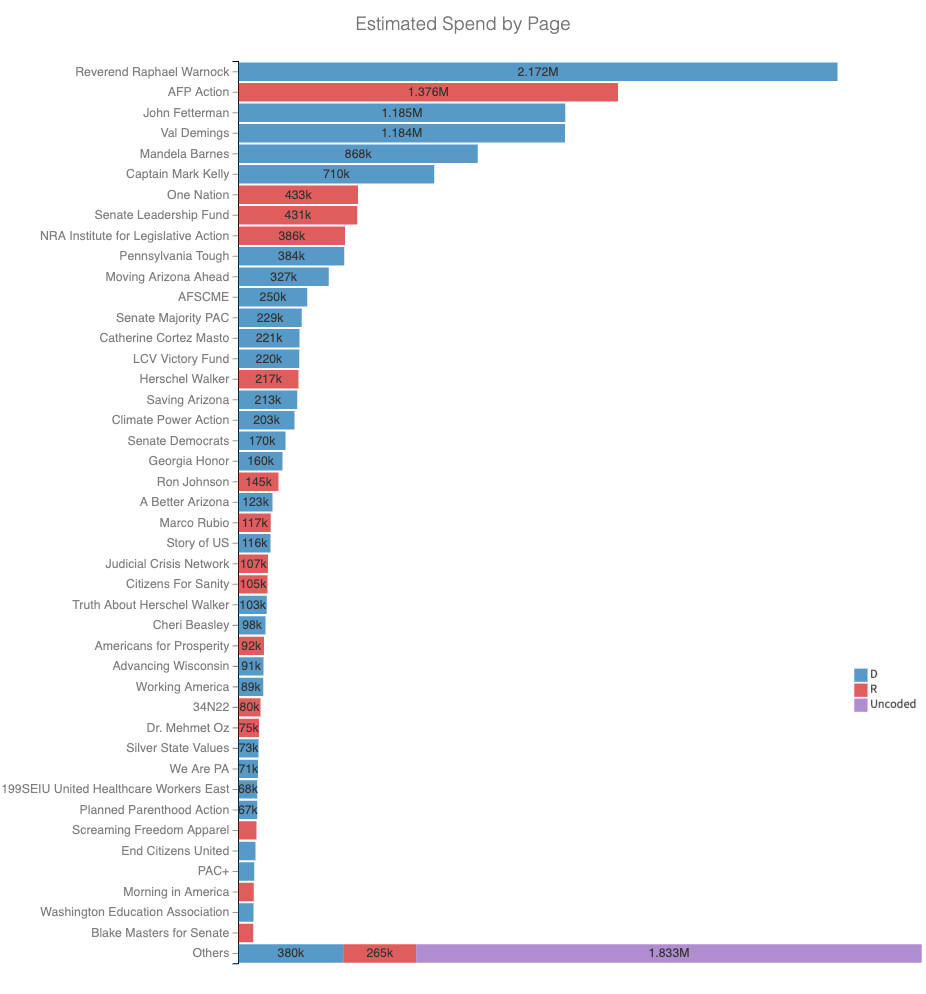
For candidates, not all of this spending occurs just in their home states. Among the biggest candidate spenders, the Warnock campaign allocates just 27% of its funds to ads in Georgia; Fetterman 36% in Pennsylvania, Val Demings 37% in Florida, and Cheri Beasley 41% in North Carolina. In contrast, the Mandela Barnes campaign spends 75% in Wisconsin, Mark Kelly 62% in Arizona, and Catherine Cortez Masto 73% in Nevada.
On the Republican side, Herschel Walker is the biggest candidate spender, and his campaign has allocated 40% of funding to Georgia. Marco Rubio spends 44% in Florida, and the Mehmet Oz campaign spends just 15% of its funds in Pennsylvania. The Ron Johnson campaign spends 92% of its funds in Wisconsin, Ted Budd spends 63% in North Carolina, and Blake Masters and Adam Laxalt spend 100% of their ad funds in-state, the only campaigns to direct all of their funds in-state (notably, these digital campaigns are smaller relative to the others in this report, with $43k and $12k spent respectively).
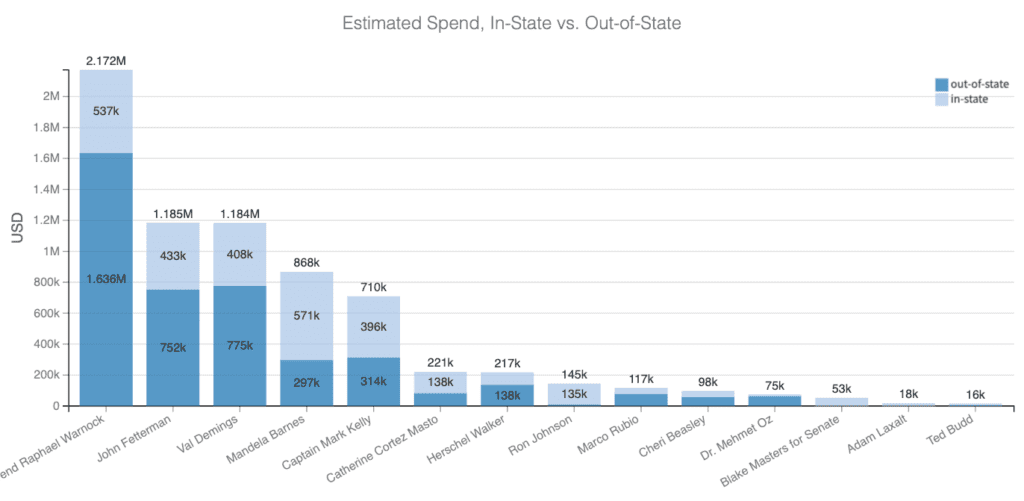
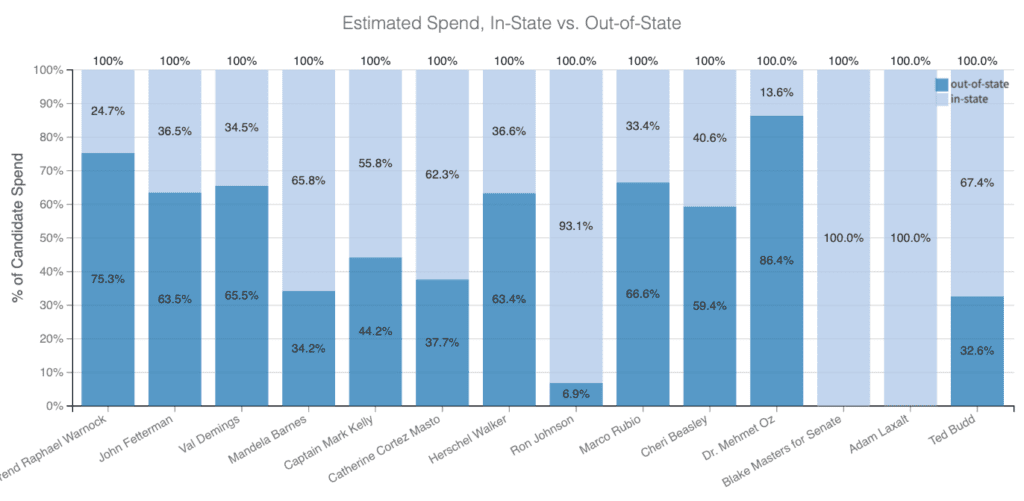
Out-of-state ads tend to be more common among the biggest overall spenders. These out-of-state ads are mainly fundraising appeals, fueling a larger campaign operation.
A few trends became clear as we looked at this data: Democrats are more likely to spend out-of-state, they’re more likely to have advanced candidate-driven digital operations, and they’re more likely to make fundraising appeals online. Their campaigns are funded by more grassroots fundraising, compared to Republican campaigns, which rely more on dark money. Republicans like to use Democrats’ out-of-state fundraising as a hook to point to Democrats as outsiders or out-of-touch, but Republicans rely on PAC money that might come from anywhere. By our count, the Johnson campaign has benefited significantly from digital ad spending on Meta platforms by supportive outside groups, including AFP Action ($308k), One Nation ($107k), Senate Leadership Fund ($79k), and NRA Institute for Legislative Action ($29k).
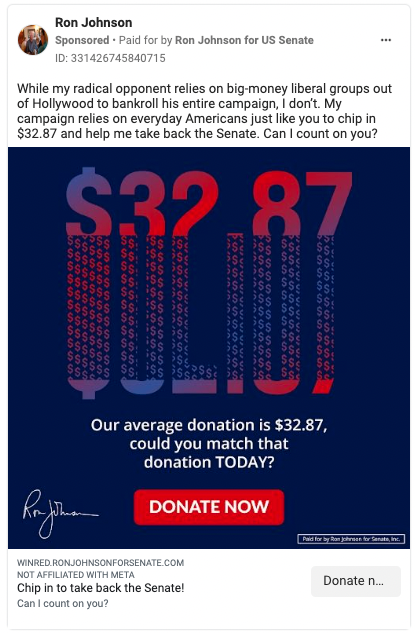
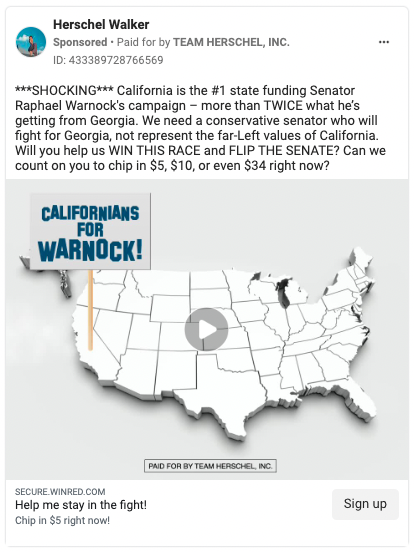
Fundraising out-of-state vs. persuasion in-state:
As an example of Democratic fundraising, this ad from Val Demings contains ten of the eleven word stems we flagged as associated with fundraising ads (”chip,” “contribut,” “deadlin,” “dollar,” “donat,” “fundrais,” “give,” “goal,” “rais,” and “midnight”), and 86% of the budget for this ad was spent outside of Florida:
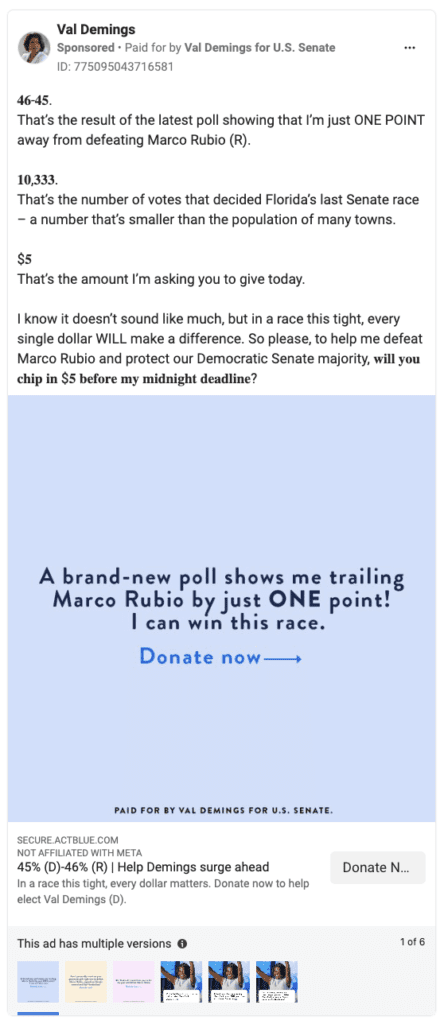
This persuasion ad from the Fetterman campaign, by contrast, was served 100 percent in Pennsylvania. The ad text contains eight of the twelve stem words we identified as associated with abortion (“abort,” “choic,” “choos,” “right,” “roe,” “wade,” “woman,” and “women”). They have spent $25 to $30k on this ad, the majority of which was directed toward women, especially women 55 and older.
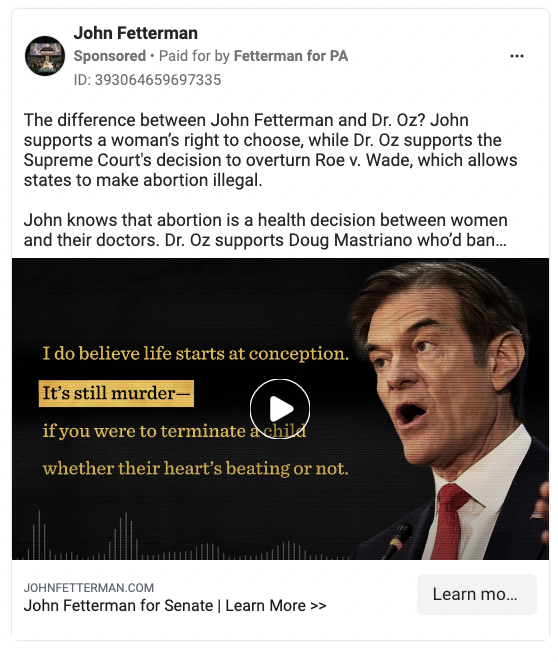
Who are they talking to?
A majority of these ads target women on Meta platforms. This may be both an intentional choice by campaigns and a reflection of the demographics of Meta users, who lean female in the US. According to Data Reportal, as of early 2022, Facebook had 179.7 million users in the US, 54.8 percent of which were female and 45.2 percent male. But it does feel significant that all of the top five biggest spenders in Democratic campaigns have spent more than 60% of their digital spend on reaching women.
In contrast, Herschel Walker’s campaign has notably spent more advertising to men: 55% vs. 44% of its total spend (estimated around $245k). The Ted Budd campaign has also spent more with male users (56% vs. 43%), but they have a considerably smaller total spend (only $16k).
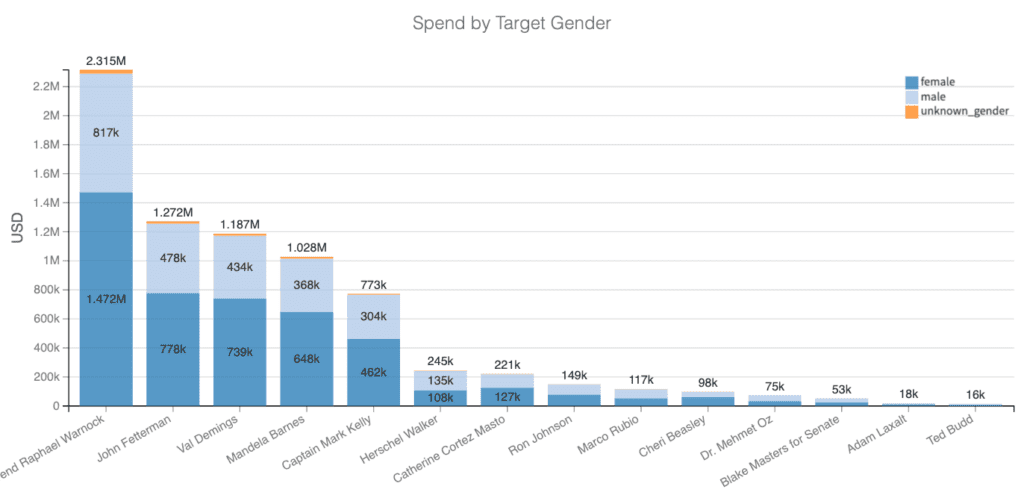
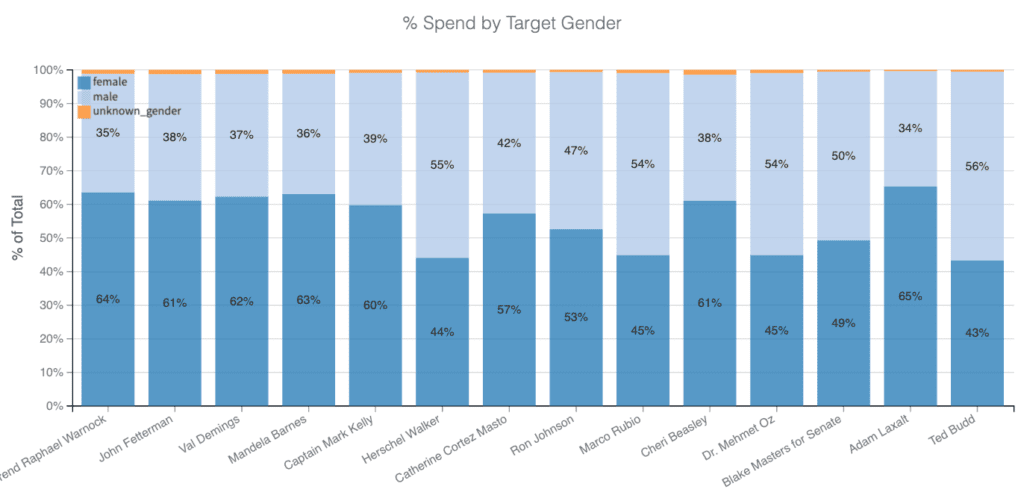
When you look at the age breakdown, many campaigns spent the majority of their budgets targeting users aged 55 and older (Warnock, Fetterman, Demings, Walker, Rubio, Beasley, Oz, and Budd).
The Mandela Barnes campaign has spent about 39% of its estimated $1 million in digital ads targeting users aged 44 or younger, the largest digital ad spender to target younger potential voters. Next is Mark Kelly’s campaign, which has spent 37% of its estimated $773k in digital ads spending targeting users aged 44 or younger.
Blake Masters and Adam Laxalt’s campaigns also stand out for their targeting of younger voters. These are smaller digital ad spenders compared to others in this report, with $53k and $18k total spent. Notably, the Masters Meta ads program only launched on October 5th, so the evolution of this campaign’s digital strategy will be one to watch.
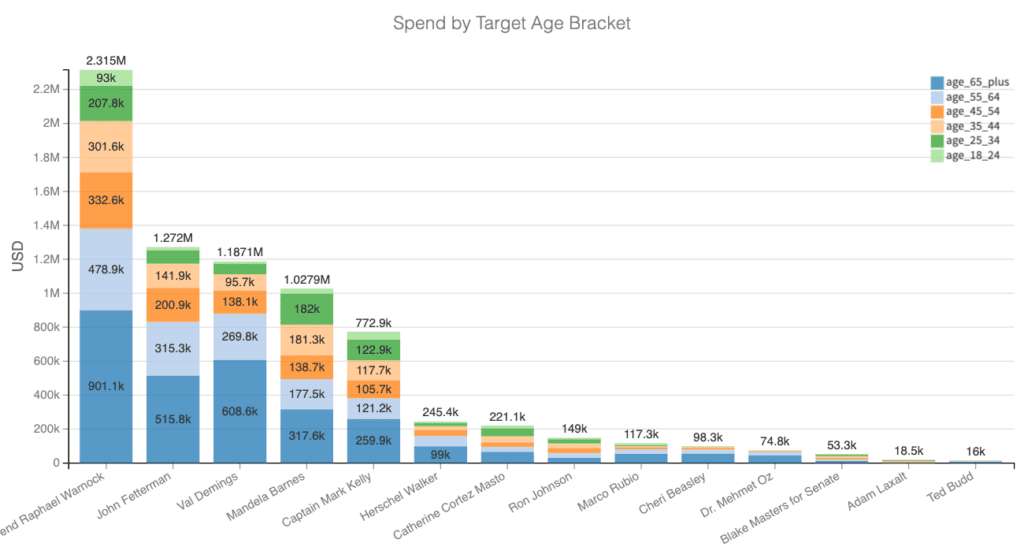
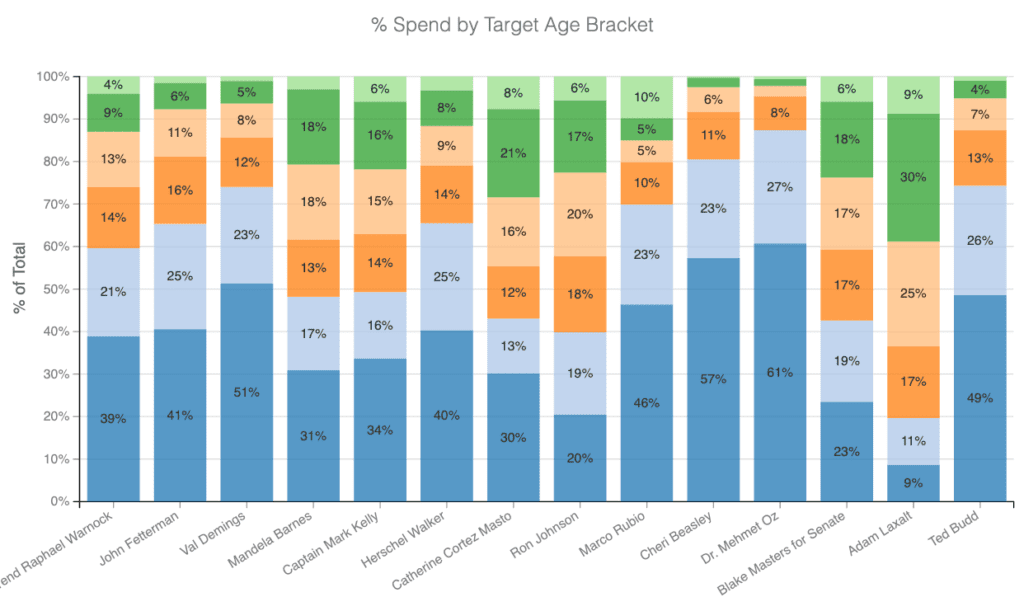

What are candidates talking about?
The top issues are (1) abortion, (2) immigration, policing, and crime (we are treating these as one issue because Republicans lump them together), and (3) the economy and inflation.
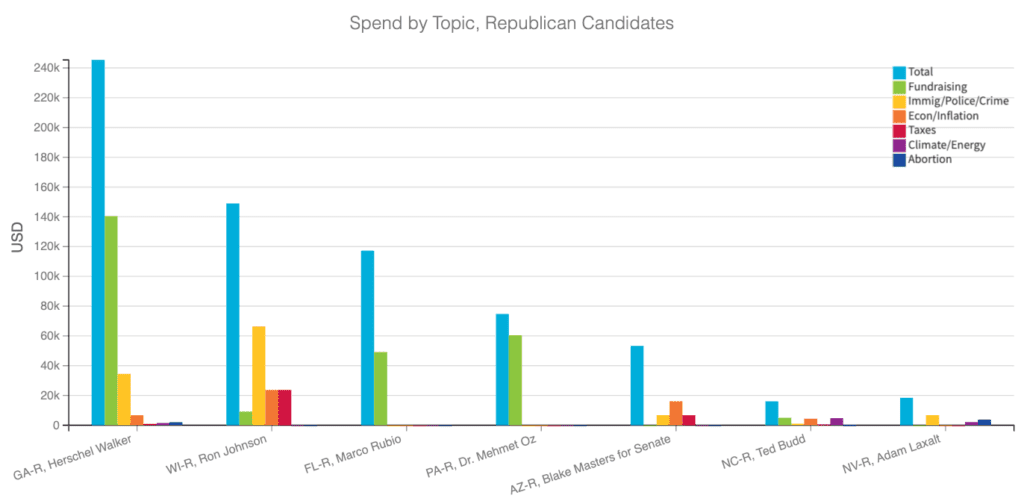
For candidates, Republicans seem to be portraying themselves as the “law and order” party. Ron Johnson, Herschel Walker, and Adam Laxalt have each spent more money on ads referencing crime, immigration, and/or policing than on the economy or inflation. Blake Masters and Ted Budd are the only Republican candidates who’ve spent more on economic ads than any other topic.
Ads that reference immigration tend to fall into a broader “law and order” Republican messaging framework that paints Democrats’ policies as chaotic and lawless. In Wisconsin, Republican Johnson has spent an estimated $66k attacking his opponent with these ads. Democrat Barnes has countered with an estimated $295k in ads refuting these claims. In other states we looked at, Herschel Walker, Blake Masters, Adam Laxalt, and Ted Budd also advertised using this right-wing messaging, with Walker spending the second highest amount, an estimated $35k on the issue.

On immigration, policing, and crime, Fetterman, Barnes, and Demings have all spent significant resources. The context for each campaign, however, is different: Barnes, most notably, is attempting to counter the Johnson campaign’s attacks, accusing him of being a radical liberal who will “abolish ICE” and “defund the police.”
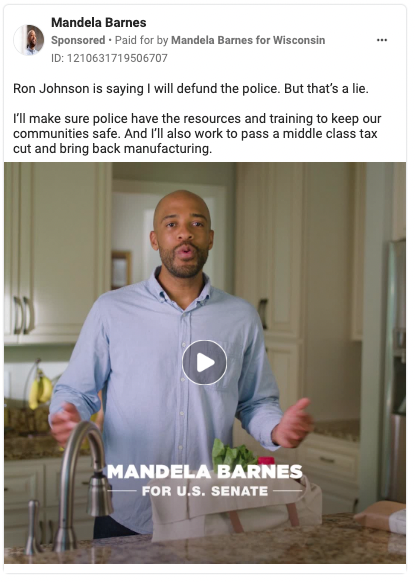
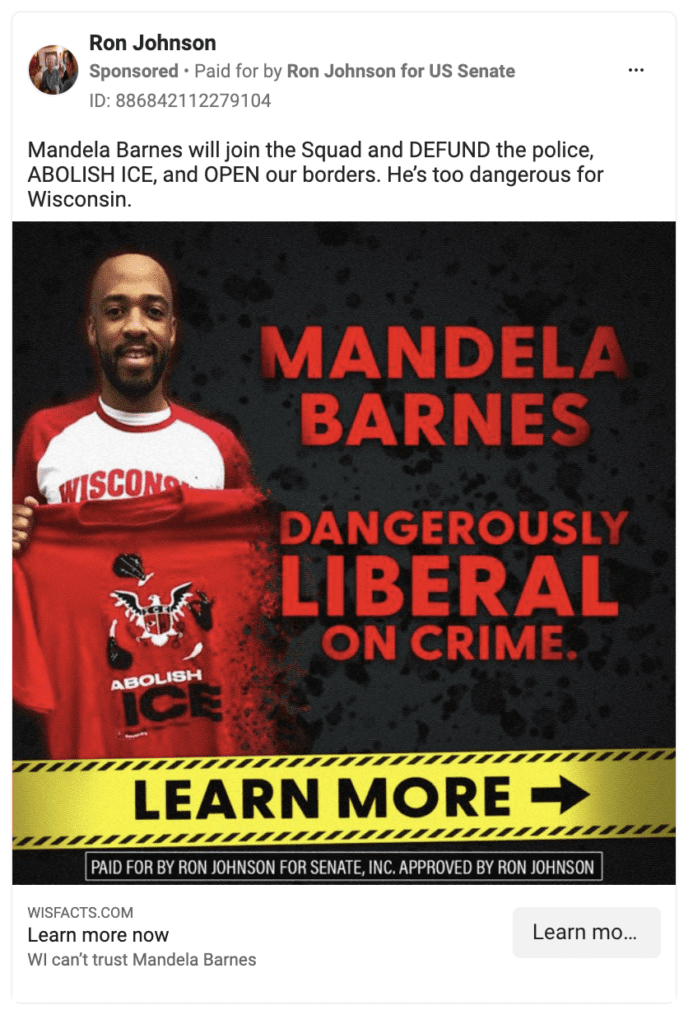
In Florida, Demings is touting her experience as a police officer as a qualification for office. In PA, Fetterman is countering attacks from Dr. Oz, highlighting his experience as mayor of Braddock and public safety as a reason he got involved in government.
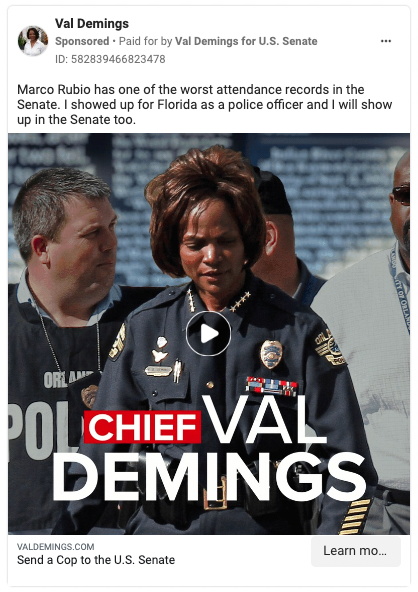
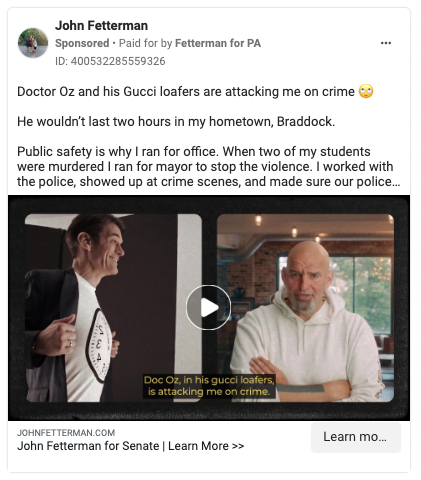
On the right, we were surprised to see Republican candidates not hammering harder on economic issues. Conventional wisdom says Republicans would own the issues on the economy and Democrats (as the incumbent party) suffer blame for the current inflation crisis and state of the stock market. Overall, we found only $58k has been spent by Republican candidates on ads that explicitly reference inflation, the economy, or gas prices in the ad body text. We took a closer look at ads from some of the biggest outside groups (more on this below) and found they spend more on the economy, inflation, and taxes.
On inflation specifically, Ron Johnson, Ted Budd, Herschel Walker, and Blake Masters have all run ads that explicitly reference inflation, spending an estimated $45k on 18 unique ads.
One such example is this ad by the Ted Budd campaign, which spent an estimated $3,200 on this ad tying Biden to inflation and linking Biden to Budd’s opponent Cheri Beasley:
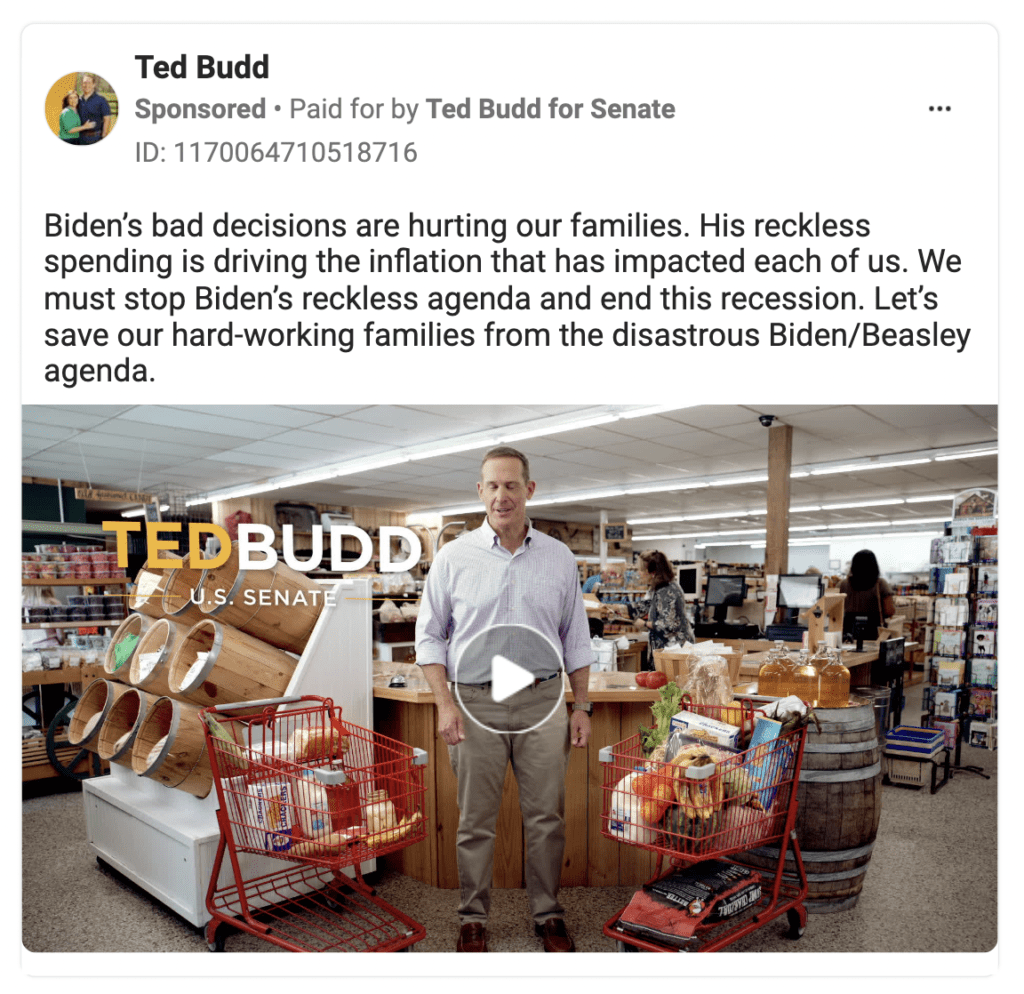
Perhaps cause for concern, we found among Democrats, only the Fetterman campaign put significant resources into ads that explicitly reference the economy or inflation ($233k). On a smaller scale, Mark Kelly and Mandela Barnes also referenced these terms, spending only $2,700 and $550, respectively. This may not be the best topic for fundraising, but it would be a mistake for Democrats to concede this issue to Republicans.
Looking at Democrats’ top topics, no one will be surprised to see they are pushing very hard on abortion rights. They clearly view this issue as a winner in these competitive states.
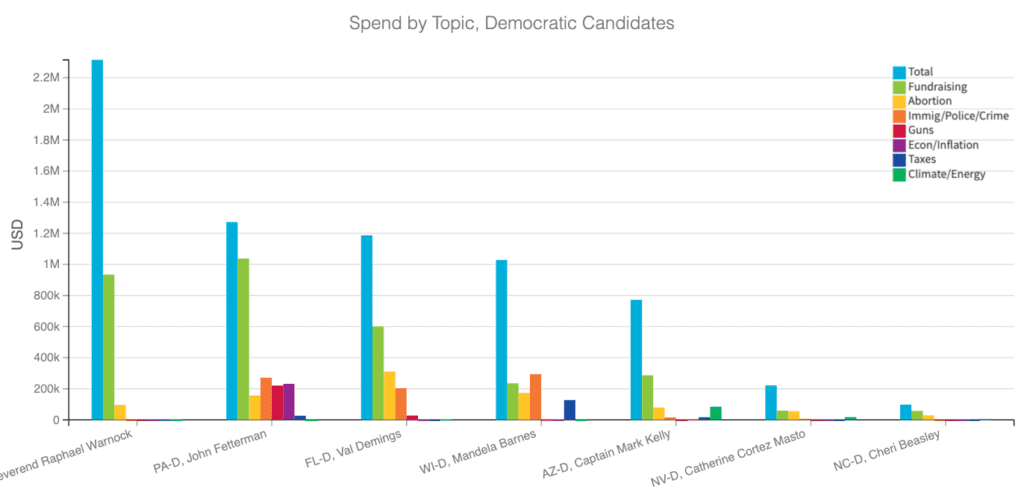
Democrats have run more than 100 ads referencing abortion and spent an estimated $900k on Meta ads on this issue, of which $574k targeted women. Val Demmings has spent the most overall on ads about abortion, at an estimated $311k.
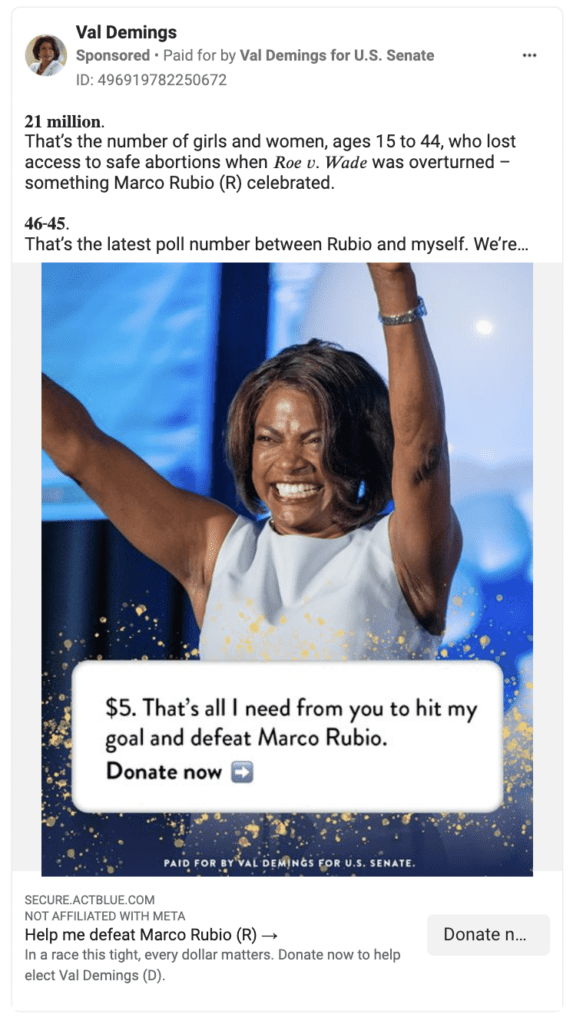
Republican candidates have published just two ads on the abortion issue, both from Adam Laxalt (NV), on the defensive. The campaign spent approximately $3,700 on these ads, primarily targeting women. Even looking at third-party groups, we did not find significant spending from PACs explicitly addressing abortion.
Top Ads
The top ads by spending from the candidates in both parties are usually fundraising appeals, often highlighting the closeness of the race or portraying their opponent as too extreme.
At this time, these are the ads the candidate pages have spent the most on:

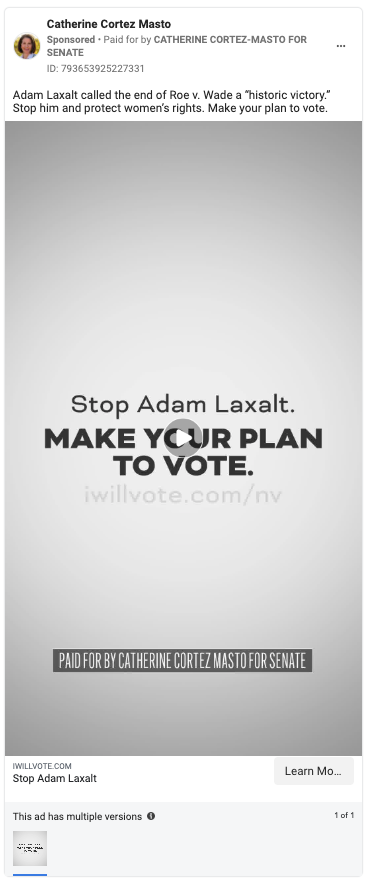
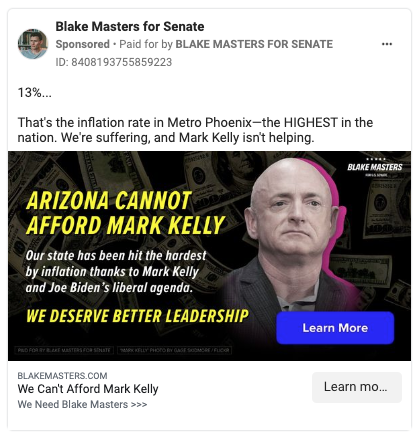
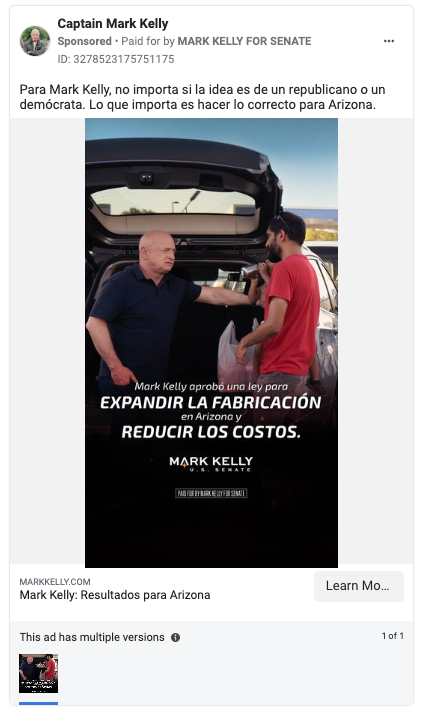
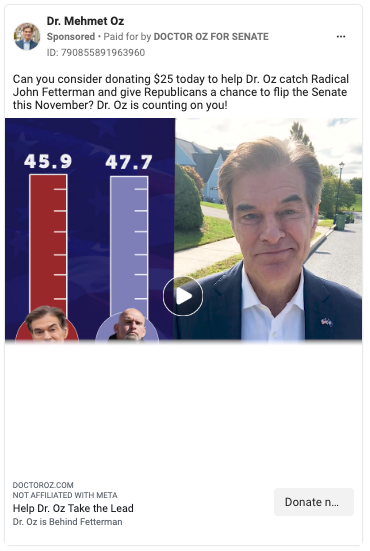
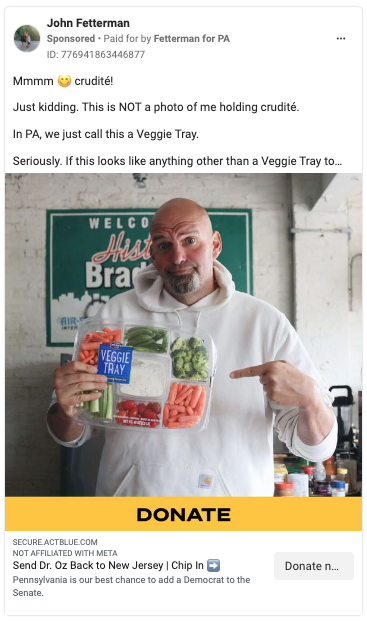

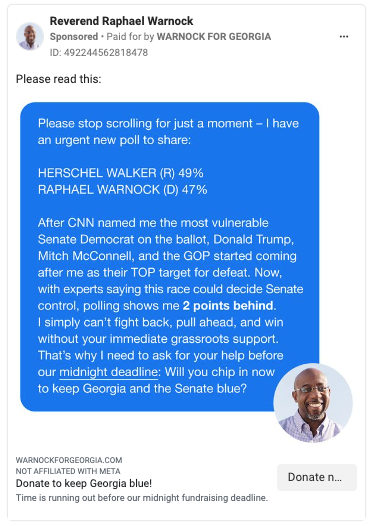
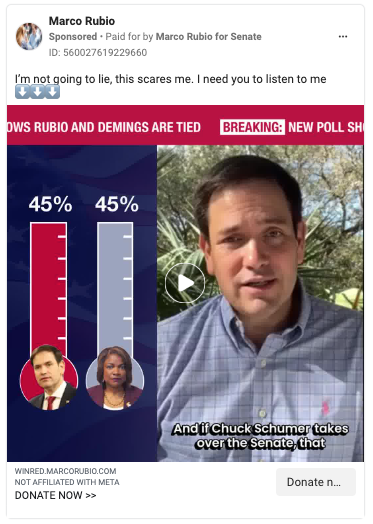
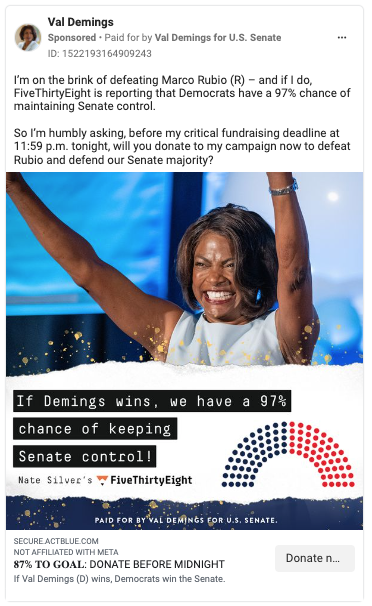
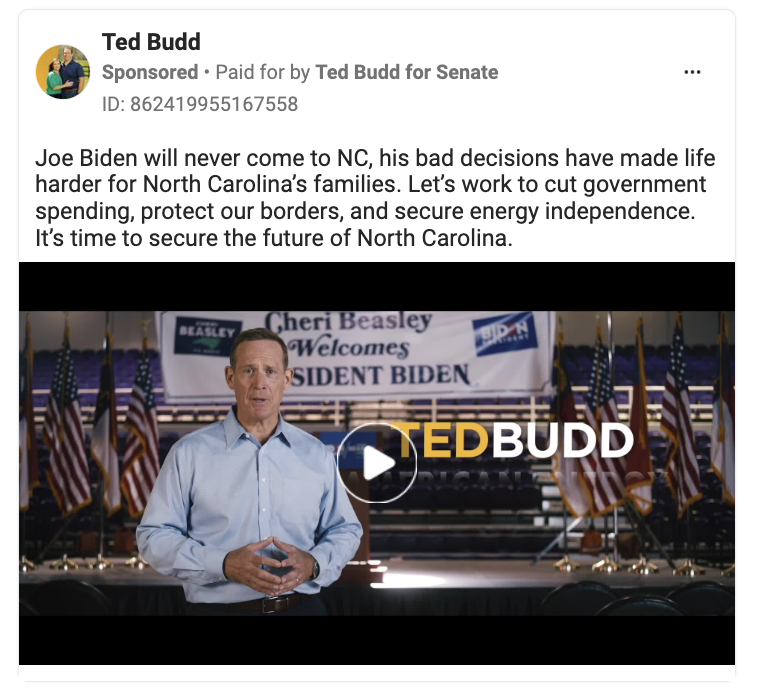
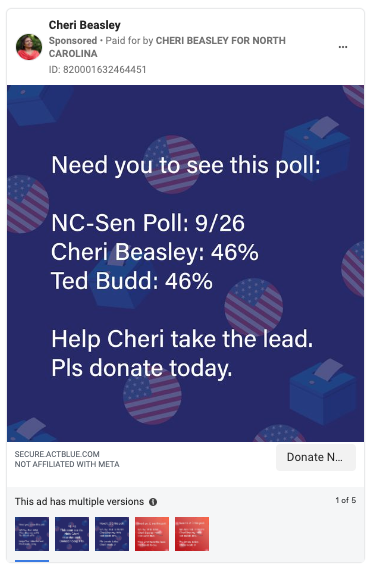
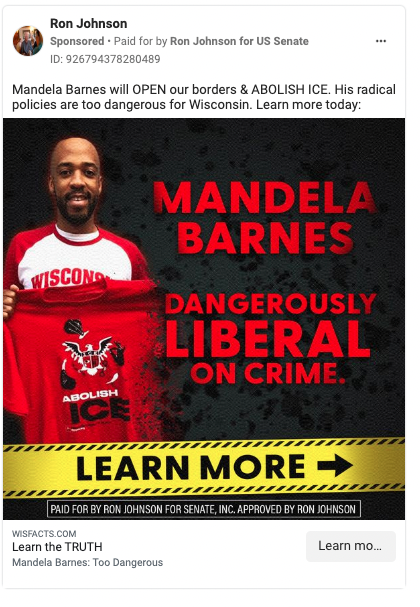
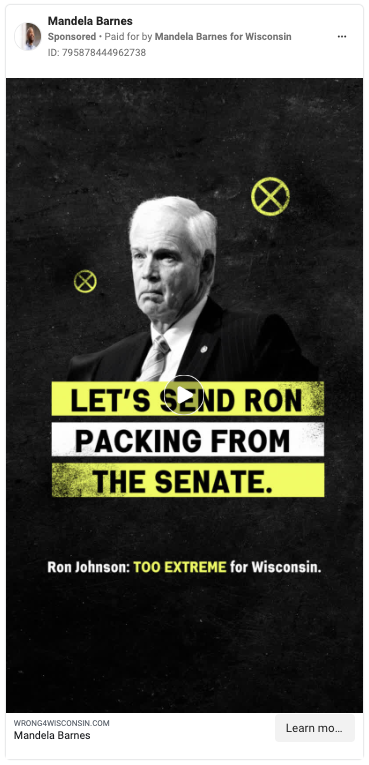
What aren’t these candidates talking about in online ads?
COVID: There was a noticeable absence of content referencing some issues that have been hot political topics in recent years. COVID was almost entirely unmentioned by either party. A few Republican ads referenced the alleged mismanagement of COVID relief funds, but we did not find references to governmental overreach in terms of vaccine or mask mandates.
Gay rights: The Supreme Court’s rightward shift and the threat it represents to gay marriage and gay rights is not breaking through as a major issue in campaign ads.
January 6th, 2021: There is only one ad we could find from a campaign discussing the Jan. 6th events and efforts to overturn our elections. It comes from the Cortez Masto campaign and attacks Adam Laxalt for his ties to insurrectionists.
Guns: Republicans are notably quiet. From the right, pro-gun ads supporting these senate candidates came only from the NRA. Democratic candidates Fetterman and Demmings have all published ads that mention the guns issue, and the Fetterman campaign is the most active, with six ads and an estimated $221 in spend on this topic. Demings has spent an estimated $28k, in ads that reference the deadly Parkland shooting or guns in schools.
Healthcare: Compared to recent past elections, very few ads mention healthcare, Medicare, or Medicaid. Most ads that reference the costs of healthcare or its limited access do so in passing, in conjunction with other issues, or their campaigns have spent little to no money on these ads.
Right-Wing PACs & Non-Candidate Groups
On the left, the biggest spenders in digital ads appear to be the candidates themselves. By contrast, on the right, the top spenders are PACs or other outside groups. AFP Action and Americans for Prosperity, One Nation, the Senate Leadership Fund, and the NRA Institute for Legislative Action have each spent more than any one candidate. This trend is evidence of how policy views of the parties and candidates impact political strategy.
We’ve looked at the top right-wing groups to see what they’re talking about and how much they’re spending on it.
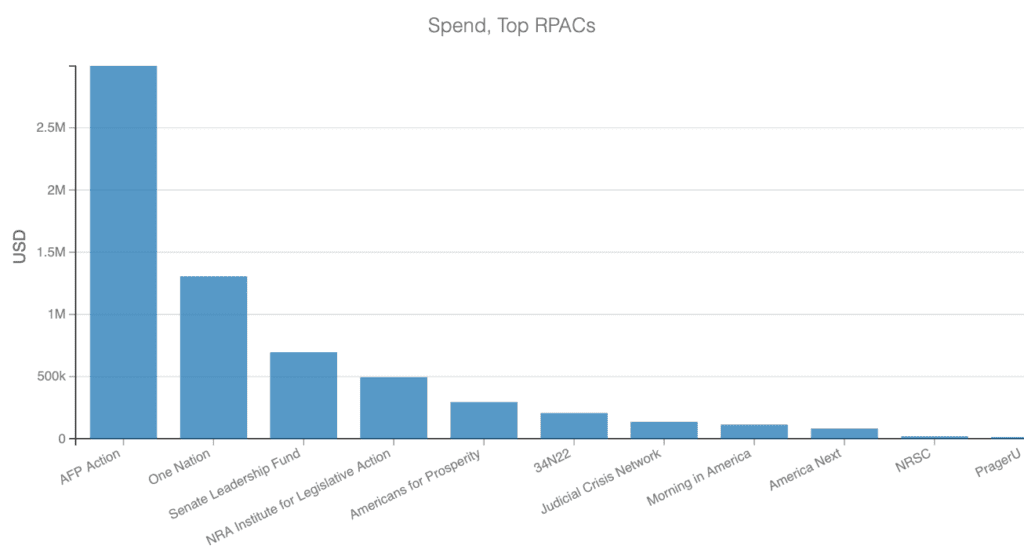
The top issues are more in line with what we expected: (1) the economy and inflation, (2) taxes, and (3) immigration, police, and crime. The NRA is the only large group running ads about guns; there are no ads on abortion or Medicare/Medicaid and healthcare.
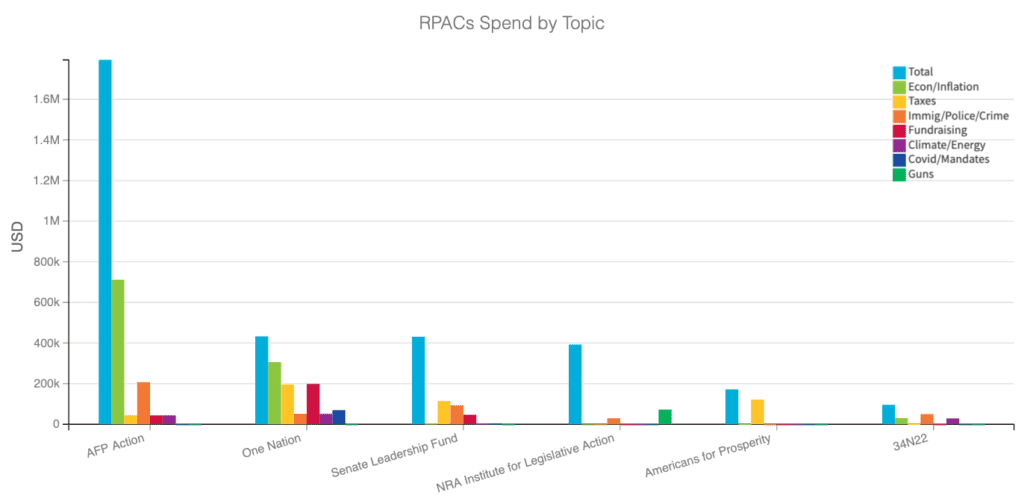
A few ads from One Nation, AFP Action, and 34N22 discuss high gas and energy prices linked to inflation.
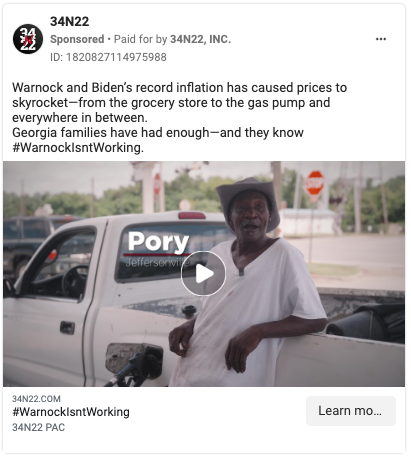
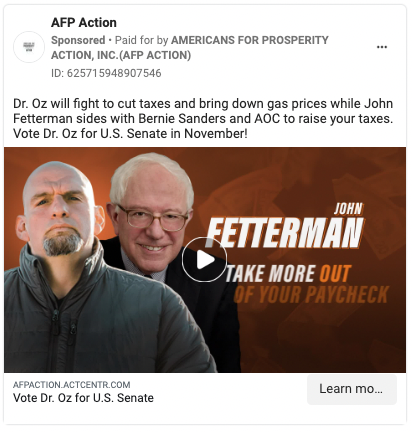
Republican PACs also attack Democrats for taxes and “reckless spending,” and many reference raising taxes “during a recession.”
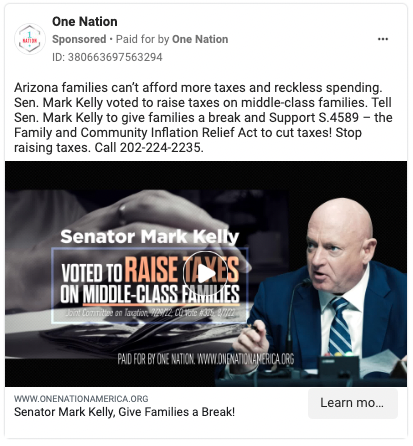
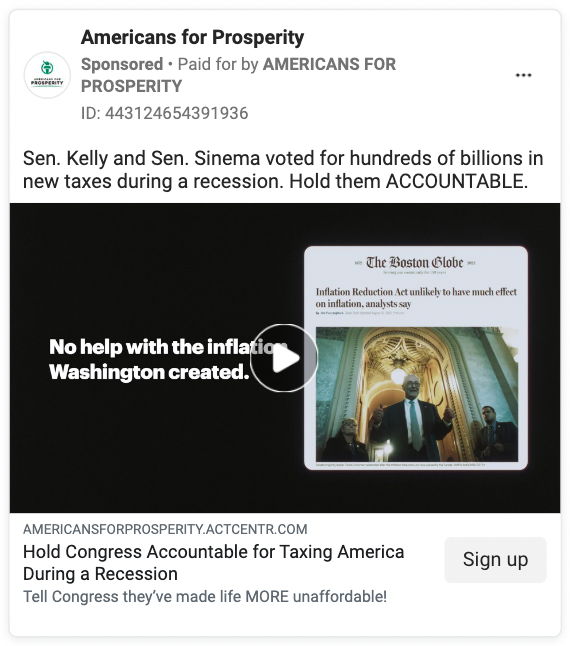
Conclusion
These ads provide a glimpse into overall campaign strategies. In 2018, the Messina Group and Navigator Research conducted an extensive analysis of paid media, and the issues are very different. The cost of healthcare, the future of Social Security, Medicare, and Medicaid, immigration (“caravans”), and the Trump tax cuts then dominated the conversation. Now, we see abortion, crime, immigration, and policing, and the economy as the central issues in this election cycle.
Over the next three weeks, we expect spending to ramp up, and while campaigns will continue fundraising, they will also shift some of their digital operations. We may see some persuasion ads in the mix, but campaigns will probably focus these ads on the specific messages that they want to drive home in the final days. We expect a growing shift towards GOTV as Election Day draws closer.
We will keep our eyes and ears open as we watch the campaigns make strategic moves, position themselves on issues, and participate in campaign-driving events like debates.

